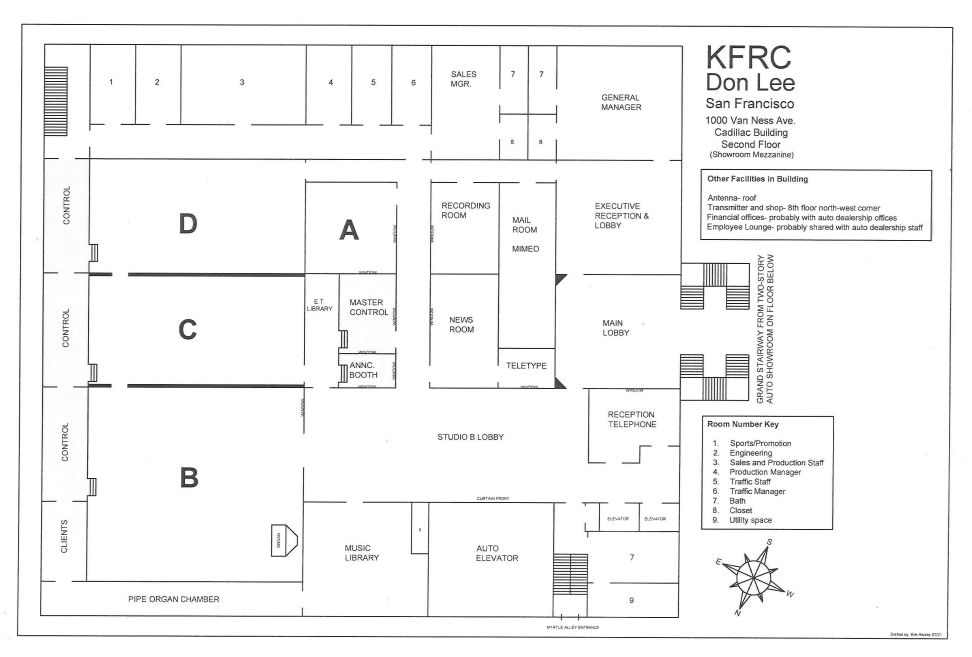KFRC Don Lee Studio Floor Plan
(As remembered by Jack Bethards)

Background Notes
Throughout the
early 1950s I haunted all of the major radio studios in San Francisco
(and, on
trips with my parents, in Hollywood, New York, and anywhere else we
stopped!).
The first radio studio I toured was NBC, New York in 1945. That focused
my
attention pretty seriously on radio.
Making the
Floor Plan
When KFRC
moved out of the building in 1957, I thought I should jot down the
layout
before I forgot it. That was unnecessary because I still remember every
detail.
Later, I think in the early 1960s, I started to work on the plan more
seriously.
I went to the building department to see if they had any permit plans
with no
results, tried the San Francisco Library and found a publicity picture
of
Harrison Holloway holding the blueprints, which got me to the current
owners of
the Don Lee building thinking those blueprints might be in their
archives. No
luck. While there I found the entire studio structure had been
demolished and
the second floor was wide open. I asked for permission to measure the
space and
made a grid to scale. I added my remembrance of the studios and
whatever else I
had seen, which did not include the offices and other spaces behind
doors
closed to visitors. After getting the drawing in the best shape I
could, I went
over it with former KFRC personnel particularly chief announcer Lew
Pfeiffer.
He was able to fill in all of the areas that were mysteries to me and
the end
result is what I think is a fairly complete picture of the plant.
The Studios
● Studio A.
Although the smallest, it was given the designation A because it had so
many
important roles. It was nicely furnished with table and chairs plus
sofa and
armchair. Thus, it served as a “speaker’s studio” for non-professional
broadcasters who needed a more “home-like” atmosphere. It served also
for news
broadcasts and other programs that had no cast or musicians. Most
important,
however, was its role as the client’s audition room ideally located
near the
sales department.
● Studio B.
This was the “auditorium” studio. It had no stage, but some shows
used a
small platform for the cast. The audience were seated in folding
chairs. I saw
several different set-ups. The most unusual feature of Studio B was a
large
round structural column in the center. All the other spaces were
designed to
fit within the building’s structural grid, but Studio B spanned two
sections.
The pipe organ was a conglomeration of parts from various organs
originally
built by the Murray M. Harris and Spencer companies cobbled together by
a local
organ maintenance firm. It sounded very fine over the air but was not a
gem of
the organ builder’s art!
● Studio D was
a medium-sized studio fully adequate for the 15- piece orchestra and
cast, plus
a very small audience.
● Studio C was
said to be similar to Studio D, but I never saw it. It was slightly
smaller
than Studio D. For sound isolation and appearance there were double
walls
hiding the structural pillars on the north and south walls.
Color
Scheme
The overall
color scheme was very light green and white. The large studios had
contrasting
schemes: Studio B in the standard light green and white; Studio C in
yellow
cream; and Studio D in tan. This is mentioned mainly because of an
interesting
story from Lew Pfeiffer. In auditioning new announcers, he would give
them a
brief tour of the studios, then sit them down in one for an audition
recording.
He would ask them to describe the studio. If they were perceptive
enough to
clearly and carefully describe the color scheme and the effect the
colors had
on the atmosphere in the room, they would get high marks.
Acoustics
The studios I
heard in action were absolutely perfect. They followed the typical
model of
that era – live bottom, dead top. Floors were hard linoleum and there
was a
hard reflective wainscot. The upper walls and ceiling were celotex.
There were
no fancy circular diffusers or other acoustical elements. The live
floor reflection
allowed for crisp, clear, articulate sound from instruments and voices.
The
upper section precluded any disturbing echo or reverberation. Listening
to a
powerful band, especially in Studio D, was an exhilarating experience –
almost
to the point of pain, but totally thrilling. An interesting note on the
acoustical quality is that the very first commercial recording ever
made from
an Ampex tape recording was made at KFRC by Ampex engineers with
portable
equipment using Lyle Bardo’s orchestra. Studios B and D did not have
the usual
sound isolating vestibules. Doors open directly into the lobby or in
the case
of Studio D, a long hallway. The B, C and D control rooms and sponsor’s
room
were most unusual in that they were backed almost entirely by large
steel-framed
factory windows often left open on a hot day.
Equipment
The only
microphones I saw in use were RCA 44A, B and BX, RCA 88, Western
Electric 618
and 639. Transcription turntables looked like RCA 70 series.
Speech input
equipment looked custom made, possibly by Remler. There was a portable
sound
effects console with transcription turntable and an Altec Voice of the
Theater
speaker. In the recording room there was a lathe and tape-recording
equipment,
but I never determined the make; I didn’t see any Ampex or Magnacord
equipment.
The transmitter was Western Electric.
Jack M.
Bethards
Benicia, CA 2021